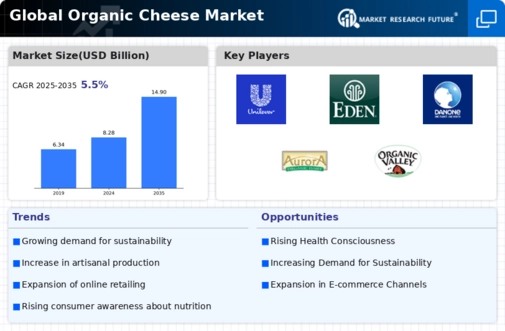Diverse Product Offerings
The Global Organic Cheese Market Industry benefits from a diverse range of product offerings that cater to varying consumer preferences. From soft cheeses to hard varieties, the availability of organic options across different cheese types enhances market appeal. This diversity allows consumers to explore new flavors and textures while adhering to their organic lifestyle. The expansion of product lines by manufacturers, including innovative flavors and artisanal cheeses, further stimulates market growth. As the market evolves, it is likely that new entrants will continue to introduce unique organic cheese products, thereby enriching the overall consumer experience.
Market Growth Projections
The Global Organic Cheese Market Industry is poised for substantial growth, with projections indicating a market size of 8.28 USD Billion in 2024 and an anticipated increase to 14.9 USD Billion by 2035. This growth trajectory suggests a compound annual growth rate (CAGR) of 5.5% from 2025 to 2035. Such figures underscore the increasing consumer preference for organic products and the expanding availability of organic cheese in various markets. The upward trend in market size reflects not only the rising demand for organic cheese but also the broader shift towards healthier and more sustainable food choices.
Rising Health Consciousness
The Global Organic Cheese Market Industry experiences a notable surge in demand driven by increasing health consciousness among consumers. As individuals become more aware of the health benefits associated with organic products, the preference for organic cheese rises. This trend is particularly evident in regions where consumers prioritize natural ingredients and sustainable farming practices. The market is projected to reach 8.28 USD Billion in 2024, reflecting a growing inclination towards healthier dietary choices. The emphasis on organic cheese, which is perceived as a healthier alternative to conventional cheese, aligns with the broader shift towards organic food consumption.
Growing Demand in Emerging Markets
Emerging markets present a significant opportunity for the Global Organic Cheese Market Industry. As disposable incomes rise and urbanization accelerates, consumers in these regions are increasingly seeking premium food products, including organic cheese. Countries in Asia and Latin America are witnessing a shift towards organic consumption, driven by changing dietary habits and a growing middle class. This trend is expected to contribute to the market's expansion, with projections indicating a potential market size of 14.9 USD Billion by 2035. The increasing availability of organic cheese in these markets is likely to further bolster consumer interest and drive sales.
Health Benefits and Nutritional Value
The health benefits associated with organic cheese significantly influence consumer choices within the Global Organic Cheese Market Industry. Organic cheese is often perceived as a healthier alternative due to its higher nutritional value and absence of artificial additives. This perception is supported by studies indicating that organic dairy products may contain higher levels of beneficial nutrients, such as omega-3 fatty acids and antioxidants. As consumers prioritize health and wellness, the demand for organic cheese continues to rise. This trend is likely to sustain the market's growth trajectory, as health-conscious individuals increasingly seek out organic options.
Sustainability and Ethical Consumption
Sustainability plays a pivotal role in shaping the Global Organic Cheese Market Industry. Consumers are increasingly inclined to support brands that prioritize ethical sourcing and environmentally friendly practices. This shift is evident in the growing demand for organic cheese produced through sustainable farming methods. As a result, many producers are adopting practices that minimize their environmental impact, which resonates with eco-conscious consumers. The market is expected to grow at a CAGR of 5.5% from 2025 to 2035, indicating a robust future for organic cheese as sustainability becomes a key purchasing criterion.
















Leave a Comment